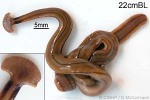Cook Islands Biodiversity Database
Species Page
Bipalium kewense
Pot-plant Flatworm
Multimedia & Additional Resources
General Information
Cook Islands Distribution
| Southern Group: Present Makatea: | ||||||||
RR |
MG |
AT |
MK |
MT |
AK |
PL |
TK |
MN |
P |
||||||||
| Northern Group: | |||||
TN |
MH |
RK |
PK |
NS |
SW |
Scientific Taxonomy
Bipalium kewense Moseley, 1878
TAXONOMY: ANIMALIA; PLATYHELMINTHES; TURBELLARIA; Seriata; Tricladida; Terricola; BIPALIIDAE
More Information
GENERAL NOTE: Land planarians mainly eat earthworms, slugs, and insect larvae. They have a particular voracious appetite for earthworms and can destroy whole populations. The prey are located by chemoreceptors on the head. The prey are held to the substrate and entangled in slimy secretions. The pharynx is protruded from the mouth and into the prey. Food is reduced to small particles and then taken into the gut system. They store food in digestive wall-cells and can survive many weeks shrinking slowly in size without feeding.
Vouchers & References
Vouchers:
Rarotonga: fieldspecimen+photo, Matavera horticultural zone house when washing a BBQ plate, possibly came out of the hose, 5/2005, Kelvin Passfield, ID via image on Pestnest Matt Purea and Peter Maddison 5/2005 as Bipalium kewense; fieldspecimen+photo, Arorangi in valley ~50m elevation on damp stone in almost dry stream, G.McCormack with ID as Bipalium kewense.
References:
None recorded.
Data Update History (information):
zTX, zB05a, zM05a, zD05a
Web Resources
Citation Information
McCormack, Gerald (2007) Cook Islands Biodiversity Database, Version 2007.2. Cook Islands Natural Heritage Trust, Rarotonga. Online at http://cookislands.bishopmuseum.org. ![]()
Please refer to our use policy.

